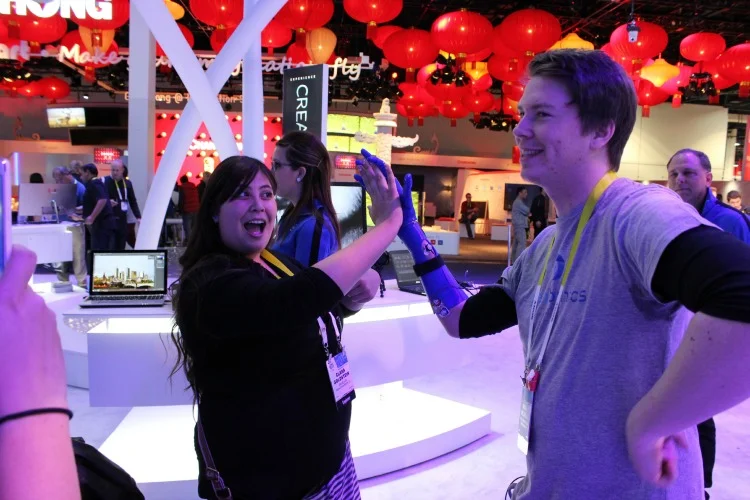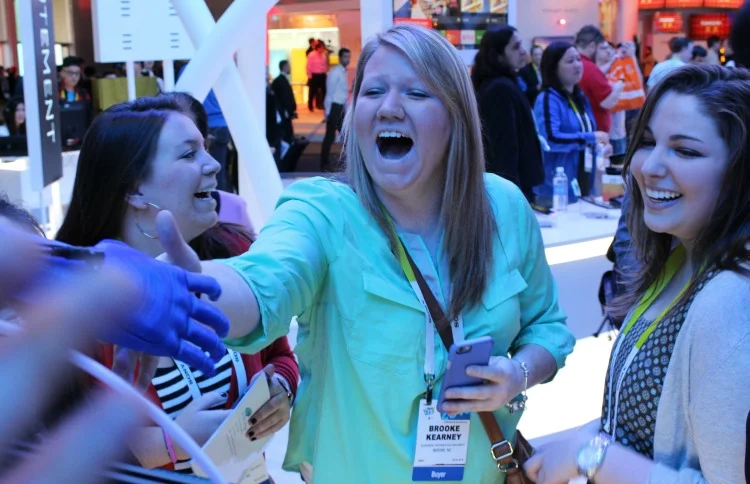Scroll down for a video of the world's most advanced 3D printed robotic prosthetic hand in action.
During the Consumer Electronics Show (CES) in January, Open Bionics trialled their latest 3D printed robotic hand by custom-fitting it to a man born without a right hand and have him wear it for five days straight.
Daniel, aged 24, and his robotic hand were such a hit at CES that after he featured on SnapChat's live feed he received a marriage proposal.
Daniel, Open Bionics' first pilot, said of the trial: “I was feeling pretty emotional being there because it has been an amazing thing to be a part of. Because I was born without a hand, essentially I've been learning to use a hand for the first time, it's really surreal. I kept shaking hands with people, and they kept asking to high-five, fist-bump, and take photos with me. It was really nice seeing how people reacted to my robotic hand, nobody shied away and I felt like I was making up for lost time.”
Open Bionics' latest robotic hand, which is now half-the weight of current robotic prosthetics, won Computer Bild's prestigious 'Best Product Innovation' award out of all the products exhibiting at CES2015.
The Bristol-based company now plans to re-design the hand to enable the prosthetic to lift heavier weights, close its fingers around smaller objects, and enable better grasping.
The inventor of the hand, 24-year-old Joel Gibbard, said: “Another thing we're working on is making the robotic hand completely wireless. Our next step is to have a fully integrated hand that is one unit. It has to be so easy-to-use that Dan can just pick it up, put it on, start using it immediately without any wires, and then re-charge it at night.”
A hand amputee can currently operate the hand by sticking electromygraphical sensors to the skin that pick up muscle activity. An amputee has to flex their residual limb muscle to tell the robotic hand to open and close.
For Dan, this was an easy process, he said: “I just put the prosthetic on, plug in the battery pack, and stick on the EMG sensors. It's great at picking up the muscle signals. I'd say it took me about two minutes to get used to it and the sensors didn't stop working for the whole trip.”
Daniel gave feedback during the week which will lead to certain advancements and a better functioning robotic hand.
Joel added: “It was interesting to watch someone adjust to wearing a bionic device, in the way that they used it naturally, and without thinking about it. Seeing Dan wearing the hand was a motivator because I saw that he could actually use it, and that it would be a benefit to him, just like we hoped it would. We could also see clearer the issues with it, that we now have to solve. It's a big push forward for us.”
Joel plans to drive the cost of robotic prosthetic devices down to under $1,000 by using 3D scanning to fit amputees and 3D printing to produce the prosthetics. He has previously 3D scanned an amputees' residual limb, 3D printed a custom-fitting prosthetic, and fit to a person in under five days.
Joel,who was recently named 'Britain's Design Engineer of The Year' has been shortlisted for Semta's 'Engineering Hall of Fame' for his groundbreaking work into 3D printed robotic prosthetics. Vote for Joel to win here: http://www.semta.org.uk/hall-of-fame-2015-shortlist



